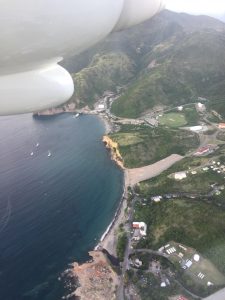This summer, I am working with the Waitt institute on developing a sustainable financing plan for ocean management for Montserrat. I was based out of Waitt’s office in San Diego, but in July, I got to travel to Montserrat.
Montserrat was like going back in time. There is one road on the island, no traffic lights, no road signs. Mangoes can be found in abundance everywhere on the island except for in grocery stores. If you’d like to eat a mango, you pick them off trees on the side of the road. No one ever thought about selling them, or buying them.
Montserrat is a volcanic dot surrounded by a sea of islands in the Caribbean Sea. It is a very tiny, but very resilient island that has undergone so much. Over the last thirty years a number of natural disasters significantly impacted the island’s ecosystem, population, and economy. The largest of these disasters was the eruption of the Soufrière Hills Volcano. In 1995, the volcano, dormant for centuries became active and erupted three times.
Since the start of the volcanic activity, the country’s population has dwindled to just under 5,000 inhabitants, about two-thirds of its count before the crisis. In addition to destroying the country’s social capital, the volcanic activity severely disrupted Montserrat’s physical capital and economy causing substantial declines in all sectors. The island’s only airport, seaport, electricity generating plant, commercial and productive activities, public buildings and residential properties within its southern environs were all destroyed or abandoned.
Prior to the volcanic eruption, Montserrat depended heavily on its natural resources to spur its economic development. Subsistence agriculture, fisheries, and tourism were primary means of livelihood. All of these sectors have been negatively affected by the volcanic activity and, today, 70% of arable land has been lost.
On Montserrat, I stayed with Robin, the Waitt Institute’s site manager on Montserrat. I rented a car and drove along the one road on the island from interview to interview. I met with government officials responsible for finance, environment, tourism, physical planning and from customs. I also spent time with the Montserrat National Trust, dive operators, and the Montserrat Yacht Association. The aim of the interviews was to fill data gaps but, most importantly, discuss potential funding mechanisms for ocean management with relevant stakeholders and hear they thoughts on whether or not specific funding mechanisms were implementable, accountable, enforceable, and socially and politically acceptable.
No one, nowhere in the world, likes additional fees and taxes, but I didn’t realize how much resistance and controversy proposing a nominal additional fee on yachts, developers on the coast, sand miners, or divers would be. Everyone wants a healthy ocean but everyone also feel someone else should financially contribute to it. Thankfully, by the end of it, a few options stood out as more feasible and acceptable than others (more on that in my next post).
The ocean and mangoes are looked at kind of in the same way in Montserrat. No one ever thought about selling a mango cause it’s something they’ve always have been able to enjoy for free and have never thought about ever having to pay for it. The same mindset applies to the ocean and its resources. However, as Montserrat moves to protect 30% of its Exclusive Economic Zone, the island is starting to realize that paying for ocean management will bring them a long way.







